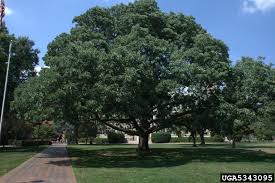Proven Tips on Caring for Older Trees
by John Campanini
Technical Director, RI Tree Council

Mature trees provide numerous benefits for both you and your property. But caring for them is critical to ensuring they remain healthy enough to provide these benefits. You have even more incentive to maintain the tree’s health of the tree if the tree is historical. Generally speaking, mature trees require the same care as younger trees.
But older trees are much less tolerant of sudden changes—even positive ones. So, if you think an older tree is in trouble, don’t hesitate to call an arborist or the Rhode Island Tree Council for help. They can provide strategies that can help you save an older tree. In the meantime, this article provides proven tips on caring for and preserving mature trees.
Common Diseases Affecting Mature Trees
Mature trees can suffer from a variety of disease problems. Anthracnose, for instance, which causes unsightly dark, sunken lesions on leaves, stems, and flowers is common among mature deciduous trees, especially sycamore, ash, and oak. Tree diseases weaken trees and make them more vulnerable to severe storms. Common diseases affecting mature trees include root rot, fungal infections, and bark beetles.
- Root rot is a deadly disease that can ravage trees. It can weaken a tree so much that it leans or breaks near the soil line. Wilting and discoloration, and dropping of a plant’s lower leaves are all signs your tree has this disease. Root rot types include phytophthora, armillaria, black, and cotton. All types of root rot are fatal. So, your best bet to preserve an older tree is to prevent this disease from occurring.
- Tree fungus is common among trees. Once fungus spores contact a tree, they grow, enter, and feed on it. But not all tree fungi are bad. Some even benefit trees. If you see mushrooms or other fungi growing around or on a tree, chances are good your tree has a fungus. Other fungi, however, are hidden below ground. Then there are those funguses that look different than expected. The loss of vigor or the discoloration of leaves is a sure sign that your tree has a fungus.
- Bark beetles breed between the bark and wood of a tree. Some species attack living trees. But most feed on weakened, dying, or dead trees. Bark beetles tend to attack one part of a tree. Some species of bark beetles speed the decomposition of wood and forest renewal. Other species can invade and kill a tree. Trees attack bark beetles by releasing their pitch or sap, which appears as reddish-brown or white blobs on the tree. If the blob is white, the tree has successfully defended itself.
If you think your older tree has any of these common problems, you need to eliminate the threats as quickly as possible. Letting them linger can kill an older tree.
Pruning Older Trees to Enhance Growth
Pruning an older tree is essential to maintaining its health. Pruning enhances the tree’s beauty, promotes its growth and development, and improves its shape and structure. Pruning also reduces the risk of disease and pests invading a tree while improving air circulation and supporting its longevity by encouraging new growth.
But you need to prune wisely and at the right time. If done incorrectly or at the wrong time, pruning can harm older trees or, at the very least, inhibit their growth. So, when is the best time to prune an older tree? The best time to prune older trees is when you see dead branches. Cut them away carefully so you don’t cause a more critical wound. But be careful when pruning branches. You don’t want them to fall and injure someone or harm your property.
Boosting Soil Health Protects Mature Trees
Enhancing soil health for older trees is another way to protect older trees from pests, insects, and diseases. Using natural fertilizers like compost, manure, and bone meal to enrich the soil with essential nutrients, for example, can boost soil health. Applying the proper soil preparation, irrigation, and fertilization techniques boost your tree’s health and make it robust enough to withstand common insect and pest infestations.
Watering Older Trees Helps Them Thrive
Watering the appropriate amount for your tree type can also help mature trees thrive. Minus a soaking rain, water regular monthly deep watering is recommended. You may also want to remove competing plants near a tree. Removing built-up soil from around the root crown also helps. It can hide defects, create areas of decay, or trap moisture from around the root crown, creating the perfect environment for fungus.
Mature trees are an essential part of our environment, providing many benefits to people and the environment. They can provide shade, cut air pollution, reduce stormwater runoff, and act as a habitat for wildlife. Older trees can also be treasures with great sentimental value. They often have much history attached to them—especially if you live in a house you were born and raised in. But you must take care of them to keep them healthy and strong. So, don’t hesitate to call an arborist or the Rhode Island Tree Council if your older tree needs help.
John Campanini is technical director of the Rhode Island Tree Council (RITree). A graduate of the University of Rhode Island, he was city forester for Providence for more than twenty years before retiring.